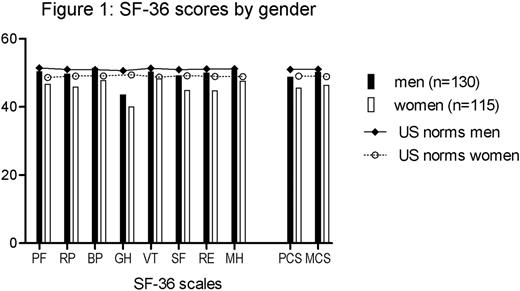Abstract
Abstract 556
Advances in the treatment of thalassemia have led to increased life expectancy, making outcomes such as health related quality of life (HRQOL) especially important in assessing interventions. However little has been published about the HRQOL of patients living with thalassemia. We report the baseline data from the Thalassemia Clinical Research Network's (TCRNs) Thalassemia Longitudinal Cohort (TLC) study.
The TCRN is an NIH sponsored network of 16 major thalassemia centers in the US, Canada and London. This study is part of the TCRN's longitudinal cohort (TLC) study. HRQOL was measured by self-report with the Medical Outcomes Study 36-Item Short Form Health Survey version 2 (SF36v2), a generic measure of functional health status and well being with results reported as 8 subscale and two summary measures. It has been validated in numerous populations and diseases, and is considered the gold standard for measuring HRQOL. We report here the results from 245 patients over the age of 14 who completed baseline assessments. Comparisons within the study population and with US norms using t-test and linear regression were performed.
There were 245 patients [47% male; mean age 29 years (range 14-58)]. When compared to US norms, TLC patients had statistically significant (p<0.05) worse HRQOL on 5 of the 8 SF36v2 subscales (physical functioning, role-physical, general health, social functioning and role-emotional) and on both summary scales (physical component summary and mental component summary). As is also seen in the US population, women had worse HRQOL than men on all subscales except vitality, and on both component summary scores. HRQOL decreased with age in all scales, more so than expected compared to US norms.
Standardized SF-36v2 Measurements: individual scales (PF=physical functioning, Rp=role-physical, Bp=bodily pain, VT=vitality, SF=social functioning, RE=role-emotional, MH=mental health) and summary scales (PCS=physical component summary, MCS=mental component summary) compared to US norms by gender. All scales range from 0-100 with higher scores indicating better quality of life
Standardized SF-36v2 Measurements: individual scales (PF=physical functioning, Rp=role-physical, Bp=bodily pain, VT=vitality, SF=social functioning, RE=role-emotional, MH=mental health) and summary scales (PCS=physical component summary, MCS=mental component summary) compared to US norms by gender. All scales range from 0-100 with higher scores indicating better quality of life
In general, adolescents and adults with thalassemia have worse HRQOL than the US population, despite contemporary therapy. Further investigation is needed to determine predictors of low HRQOL so that these may be better addressed by a multidisciplinary team.
No relevant conflicts of interest to declare.
Author notes
Asterisk with author names denotes non-ASH members.


This feature is available to Subscribers Only
Sign In or Create an Account Close Modal